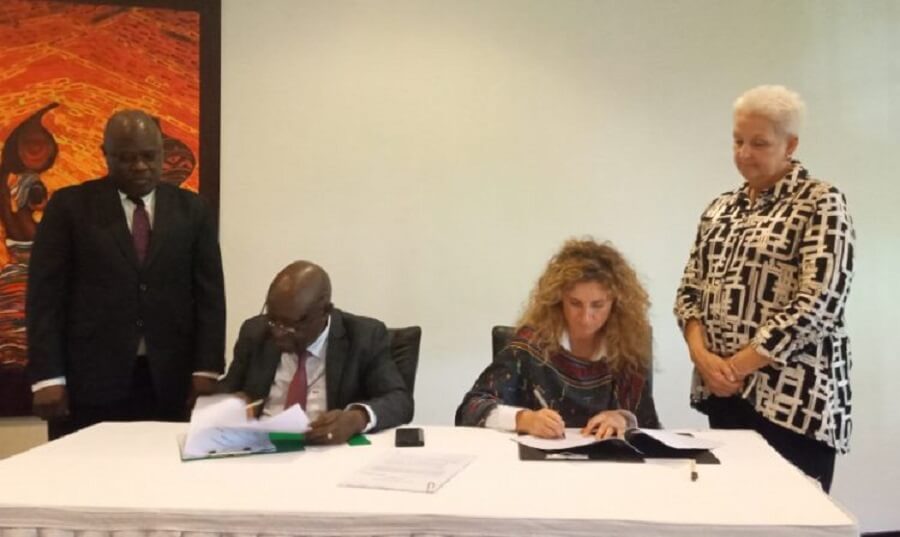
Outgoing Uganda Minister of Tourism Wildlife & Antiquities, Prof. Ephrahim Kamuntu, this morning, December 16, 2019, unveiled the mountain gorilla populations in the Greater Virunga Conservation Area by declaring the long-awaited global number of the endangered species between Rwanda, DRC (Democratic Republic of Congo), and Uganda. This was after the release of the December 2018 Census results released at the Kampala Serena International Conference Centre.
Emceed by UWA (Uganda Wildlife Authority ) Public Relations Officer, Gessa Simplicious, the unveiling was presented in collaboration with the Greater Virunga Transboundary and Bwindi-Sarambwe ecosystem revealing that the number of gorillas (gorilla beringei) in the 340-square-kilometer boundary of protected forest to have increased to 459 in 50 groups and 13 individuals up from an estimated 400 in 2011.

Combined with the published results of the Virunga Mastiff 2015/16 survey of 604, the global figure stands at 1,063. The findings put to rest speculation on gorilla numbers pitting Uganda at 51% of the total population and the remaining 49% shared between the 3 countries.
This is the fifth count for this area and the first to include Sarambwe Nature Reserve since surveys began in the 1970s.
The Survey
Preceding the honorable minister’s announcement, the Warden of the Ecological Monitoring and Research Bwindi Mgahinga Conservation Area (BMCA), Joseph Arinitwe, said the process started from the eastern end of the forest to the Sarambwe Nature Reserve in the west
It involved more than 75 trained survey members in 6 teams in 250 to 500-meter stretches with the support of local governments and communities living around the protected areas. They moved at standard intervals at agreed times in shifts of 2 weeks each collecting elephants, duikers, and gorillas fecal matter from fresh nests whereby samples were collected and preserved for genetic analysis. Additional publications are expected from the survey. Signs of human activity were also studied. The team persevered through challenging rugged terrain, floods, twigs, and insect bites
Arinitwe emphasized the importance of surveys in monitoring trends and to prove that conservation strategies are working.

Uganda Wildlife
Representing the Board of Trustees for the Uganda Wildlife Authority (UWA), Dr. Pantaleon Kasoma reiterated the value of the income generated from the gorillas, noting that there are other conservation areas in the country that do not generate income that are sustained by revenue from gorillas.
Tourism State Minister Honorable Suubi Kiwanda thanked the outgoing minister for his effort to turn around Human-Wildlife Conflict into Human-Wildlife Relationship having traversed the country to sensitize communities surrounding the National Parks and Wildlife corridors as well as revenue sharing.
Outgoing Minister’s Last Words
In what could be deemed as his last speech before revealing the census results, Professor Kamuntu spared a moment to welcome the incoming Tourism Minister Hon. Tom Butime. Also in attendance were Japanese Ambassador to Uganda Kazuaki Kameda; Tourism State Minister Suubi Kiwanda; Permanent Secretary MTWA Doreen Katusime; Director of Tourism Mr. James Lutalo; Dr. Andrew Seguya, Executive Secretary at Greater Virunga Transboundary Collaboration; Dr. Gladys Kalema, Conservation Through Public Health (CTPH); Executive Director UWA, Sam Mawanda; Director of Business Services UWA, Stephen Masaba; Professor Robert Bitariho of Mbarara University; and ITFC (Institute of Tropical Forest Conservation) Jonathan Ainebyona PRO – Association of Uganda Tour Operators(AUTO) and a host of other scientists and researchers.
Citing the Constitution of The Republic of Uganda Professor Kamuntu stated, “The Constitution of The Republic of Uganda is enshrined to protect and promote important natural resources including land, air, wetlands, flora, and fauna on behalf of future generations.”
On religion, he said, “God created man and woman and gave the earth under man’s charge. Therefore, we have custodial responsibility to conserve not only for Ugandans but for the entire human race.”
We Thank You
He thanked representatives of international organizations, stating that the gorillas would have been wiped out without their support. They include IGCP (International Gorilla Conservation Program), ICCN (Institut Congolais pour la Conservation de la Nature), RDB (Rwanda Development Board), ITFC (The Institute of Tropical Forest Conservation), WCS (Wildlife Conservation Society), CTPH (Conservation Through Public Health), Diane Fosey Gorilla Fund, WWF (World Wildlife Fund), BMCT (Bwindi Mgahinga Conservation Trust), IGCP (The International Gorilla Conservation Program), Gorilla Doctors, and UC Davis.
In addition to gorillas, he said the country hosts the Big Five Plus Two – namely the gorillas and chimpanzees; 11% of bird species globally accounting for 50% of Africa’s species; 39% of mammals; 19% of amphibians; 1,249 species of butterflies; and 600 species of fish.
“Tourism is a transformative force fueling the development of Uganda with US$1.5 billion in foreign exchange earnings and 8% of the labor force with 10% of the landmass devoted to conservation,” said the minister.
A Positive Path
He attributed the increase in gorilla numbers and wildlife in general as representing a positive path to development surpassing pre-independence numbers. However, he acknowledged the challenges that come with increasing numbers including pressure from human populations.
He reiterated that Uganda remains committed to the Greater Virunga Wildlife Transboundary Conservation, because the gorillas provide an example that we must remove borders between humans. Representatives from Rwanda and DRC were conspicuously absent.
Discovered only in 1902, Captain Robert von Beringe in his quest to map the boundaries of German East Africa, gorillas were eventually brought to world attention by researcher Diane Fossey who inspired by Dr. Leakey dedicated and gave her life to research on the gorillas and the famous former “poacher dog,” Digit, the mountain gorilla with whom she formed a bond in life and death inspiring the 1988 drama “Gorillas in The Mist.”